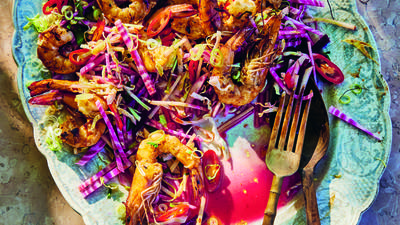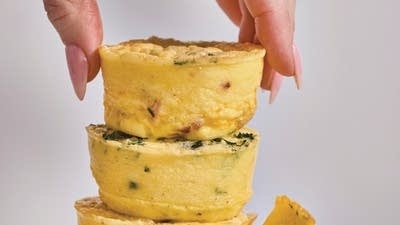
How do you feed 9 billion people? That's an estimate of how many people will be living on the planet in 40 years -- on a planet whose climate is changing faster than scientists predicted.
National Geographic tackles this question in the magazine and on natgeofood.com, an eight-month series on issues of food security and sustainability. Dennis Dimick, the executive editor of the magazine, explains Jonathan Foley's recent article, "Feeding 9 Billion: A Five-Step Plan to Feed the World."
Dennis Dimick: It originated in a research paper that [Jonathan Foley] and a team from the University of Minnesota and other universities assembled and published in the journal Nature in October of 2011. What we did with Jon is distill that down.
 Dennis Dimick
Photo: © National Geographic
Dennis Dimick
Photo: © National Geographic
Step One: Freeze Agriculture’s Footprint
DD: We need to stop cutting forests and plowing grasslands to improve food productivity. That's how historically we have done it in the past to raise the amount of food we grow -- we just cut forests and plow grasslands. If you want to save forests, if you want to save tigers, if you want to save ecosystems, we need to stop that.
Step Two: Grow More on Farms We’ve Got
DD: Another step is really taking a look at the farms that we already have. What can we do to improve output yields from all of those farms, especially in places like Africa, Latin America and eastern Europe? There's this idea called yield gap, which means the difference between what many farms are doing and what could be done in a particular area.
Step Three: Use Resources More Efficiently
DD: There's a third dimension here: using resources more efficiently. This is a really fascinating area where agriculture is becoming much more efficient in its use of fertilizers, water and energy to try to do things like reduce nitrate runoff pollution that creates dead zones. But also as we see more droughts around the world, the idea that we can get more out of the water that we have available so that we can keep growing crops.
[Ed. note: Pictured above, workers harvest celery on the Bassetti farm near Greenfield, California, to be shipped to retail outlets in the U.S. and Asia. Dubbed “America’s salad bowl,” the Salinas Valley relies on groundwater for irrigation, which could be at risk if the current drought continues.]
It's important to note that this is really not a big ag versus organic kind of view -- everybody has a contribution here. Organic farming can greatly reduce the use of water and chemicals by using things like cover crops, mulches and compost. Everybody has a contribution to make.
 Food Versus Feed and Fuel: Percentages on the map show whether most of the calories in a region’s crops go directly to human consumption (green) or go to animal feed and biofuels (purple). Only 55 percent of the world’s food-crop calories directly nourish people. We get another 4 percent indirectly by eating meat, dairy, or eggs from animals raised on feed. (Graphics and map by Virginia W. Mason and Jason Treat, NGM Staff. Source: Global Landscapes Initiative, Institute on the Environment, University of Minnesota.) Click here to view a full version of the map.
Food Versus Feed and Fuel: Percentages on the map show whether most of the calories in a region’s crops go directly to human consumption (green) or go to animal feed and biofuels (purple). Only 55 percent of the world’s food-crop calories directly nourish people. We get another 4 percent indirectly by eating meat, dairy, or eggs from animals raised on feed. (Graphics and map by Virginia W. Mason and Jason Treat, NGM Staff. Source: Global Landscapes Initiative, Institute on the Environment, University of Minnesota.) Click here to view a full version of the map.
Step Four: Shift Diets
 National Geographic (Credit: National Geographic)
National Geographic (Credit: National Geographic)
DD: This question of how much meat and what kind? When you take a look at what our crops are being grown for -- if you look, for example, around the world, 55 percent of crops are grown to feed people, and 45 percent or the remainder are grown to feed livestock and for things like energy.
If you're trying to get more calories to people, the question is how much meat? What kind: beef, chicken or pork? How much of that can we afford to feed when we know that, for example, a pound of beef might take 10 pounds of grain, a pound of chicken might take 4 pounds of grain, fish can take slightly over a pound?
In one sense, as an individual, you could decide, "Well, I'm going to eat less beef and eat more fish." By doing that, you reduce the amount of land, water and energy that are being devoted to provide for what you put in your market basket.
If you take a look at an acre of corn, for example, in round numbers in the U.S., this is not sweet corn, this is field corn. When you're traveling across Iowa or Illinois, you see it in large fields. About half of that goes to feed cattle. About a quarter goes now to feed cars. Most of the rest goes to create what's called high-fructose corn syrup, which is sugar.
That's something to think about because to think that we're growing this stuff to feed people -- actually these feed-grade corns are not really specifically designed to feed to people. So if you were going to change the use of the landscape, you're going to have to grow a different kind of crop.
 At the Nutribras pig farm in Mato Grosso, Brazil, sows are confined to sectioned crates that allow a mother to suckle her piglets without accidentally crushing them. Hog farms can be big polluters -- the average 200-pound pig produces 13 pounds of manure a day -- but Nutribras recycles waste as fertilizer and methane power.
Photo: © George Steinmetz / National Geographic
At the Nutribras pig farm in Mato Grosso, Brazil, sows are confined to sectioned crates that allow a mother to suckle her piglets without accidentally crushing them. Hog farms can be big polluters -- the average 200-pound pig produces 13 pounds of manure a day -- but Nutribras recycles waste as fertilizer and methane power.
Photo: © George Steinmetz / National Geographic
Step Five: Reduce Waste
DD: The last piece really is about reducing waste. There are two parts of this. On the front side, on the farm, production, marketing side, in many under-developed countries and nations that have poor roads, storage and refrigeration, a lot of food could be saved if we had better systems to capture the crop as it's coming off of the field and it's kept refrigerated, or we keep bugs and insects out of the grains. That has a huge impact. That's one kind of food waste that could make more food available for people.
But on the other side of that coin, when we look here in the U.S., anywhere from 40 to 50 percent of the food that we have available to us here in this country is thrown away.
Before you go...
Each week, The Splendid Table brings you stories that expand your world view, inspire you to try something new, and show how food connects us all. We rely on your generous support. For as little as $5 a month, you can have a lasting impact on The Splendid Table. And, when you donate, you’ll join a community of like-minded individuals who love good food, good conversation, and kitchen companionship. Show your love for The Splendid Table with a gift today.
Thank you for your support.
Donate today for as little as $5.00 a month. Your gift only takes a few minutes and has a lasting impact on The Splendid Table and you'll be welcomed into The Splendid Table Co-op.




